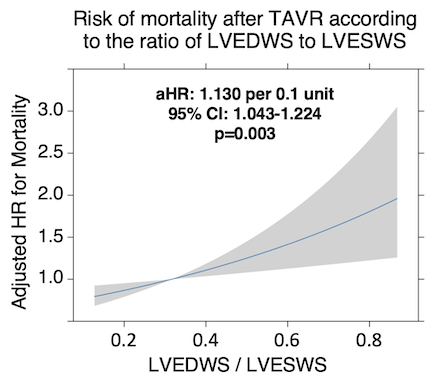Final ID: P3013
Left Ventricular Diastolic to Systolic Wall Stress Ratio and Mortality Following Transcatheter Aortic Valve Replacement
Abstract Body: Background: Most studies of left ventricular wall stress in patients with aortic stenosis (AS) focus on the end systolic (LVESWS) component with suggestion of an inverse association with adverse outcomes. LV end diastolic wall stress (LVEDWS) is less characterized and LVEDWS to LVESWS ratio, which may provide a combined measure of diastolic and systolic dysfunction and remodeling, has not been previously reported in patients with severe AS undergoing transcatheter aortic valve replacement (TAVR).
Hypothesis: Higher LVEDWS to LVESWS ratio assessed by echocardiography prior to TAVR associates with greater risk of post-TAVR death.
Methods: From a multicenter registry of patients with severe AS undergoing TAVR, we examined 637 participants (median age 84 years, 43% female, 95% white) who underwent pre-TAVR echocardiogram from which LVEDWS and LVESWS could be calculated from chamber dimensions, wall thicknesses, aortic valve gradient, blood pressure, and E/e’. Multivariable-adjusted Cox regression was used to examine associations between LVEDWS, LVESWS, their ratio, and the risk of post-TAVR mortality.
Results: Median LVEDWS, LVESWS, and LVEDWS/LVESWS ratio were 22.1 (IQR: 16.2, 29.7) kdynes/cm2, 64.7 (IQR: 50.0, 90.7) kdynes/cm2, and 0.32 (IQR: 0.24, 0.43), respectively. Correlates of higher LVEDWS/LVESWS included: female gender, non-white race, hypertension medication use, higher natriuretic peptide and LV ejection fraction, and lower systolic and diastolic BP and hemoglobin. Over a median follow-up of 3 years post-TAVR, 262 (41%) individuals died. Higher LVEDWS tended towards greater risk of death (aHR: 1.013; 95% CI 0.999 – 1.027, p=0.071), while higher LVESWS associated with lower mortality risk (aHR: 0.993; 95% CI 0.988-0.998, p=0.008). Higher LVEDWS/LVESWS ratio associated with greater risk of death (aHR: 1.130, 95% CI 1.043-1.224, p=0.003, per 0.1 unit) (Figure), independent of age, comorbidities, LVEF, mass index, natriuretic peptide, and troponin.
Conclusion: Among patients with severe aortic stenosis, higher LVEDWS to LVESWS ratio prior to TAVR associated with greater risk of post-TAVR mortality.
Hypothesis: Higher LVEDWS to LVESWS ratio assessed by echocardiography prior to TAVR associates with greater risk of post-TAVR death.
Methods: From a multicenter registry of patients with severe AS undergoing TAVR, we examined 637 participants (median age 84 years, 43% female, 95% white) who underwent pre-TAVR echocardiogram from which LVEDWS and LVESWS could be calculated from chamber dimensions, wall thicknesses, aortic valve gradient, blood pressure, and E/e’. Multivariable-adjusted Cox regression was used to examine associations between LVEDWS, LVESWS, their ratio, and the risk of post-TAVR mortality.
Results: Median LVEDWS, LVESWS, and LVEDWS/LVESWS ratio were 22.1 (IQR: 16.2, 29.7) kdynes/cm2, 64.7 (IQR: 50.0, 90.7) kdynes/cm2, and 0.32 (IQR: 0.24, 0.43), respectively. Correlates of higher LVEDWS/LVESWS included: female gender, non-white race, hypertension medication use, higher natriuretic peptide and LV ejection fraction, and lower systolic and diastolic BP and hemoglobin. Over a median follow-up of 3 years post-TAVR, 262 (41%) individuals died. Higher LVEDWS tended towards greater risk of death (aHR: 1.013; 95% CI 0.999 – 1.027, p=0.071), while higher LVESWS associated with lower mortality risk (aHR: 0.993; 95% CI 0.988-0.998, p=0.008). Higher LVEDWS/LVESWS ratio associated with greater risk of death (aHR: 1.130, 95% CI 1.043-1.224, p=0.003, per 0.1 unit) (Figure), independent of age, comorbidities, LVEF, mass index, natriuretic peptide, and troponin.
Conclusion: Among patients with severe aortic stenosis, higher LVEDWS to LVESWS ratio prior to TAVR associated with greater risk of post-TAVR mortality.
More abstracts on this topic:
A Remedy for the Heart and the Hemoglobin: Improvement in Anemia Post Transcatheter Aortic Valve Replacement
Matta Raghav, Roy Aanya, Hammad Bayan, Draffen Arvind, Natsheh Zachary, Tiu Daniel, Tiu David, Salem Edward, Balami Jesse, Kalagara Swetha, Gupta Neil, Uraizee Omar, Sahgal Savina, Mishra Atreya, Ene Adriana, Hattab Aleyah, Arora Aarushi, Sufyaan Humam, Dau Trang, Silberstein Jonathan, Yu Julia, Torres Kayla, Seshadri Suhas, Navarro Laura, Singam Manisha, Ismail Mariam, Rana Riya, Habeel Samer, Liu Simon, Chaganti Srinidhi, Gurbuxani Vidur, Dwyer Kaluzna Stephanie, Groo Vicki, Carlson Andrew, Shroff Adhir, Bhayani Siddharth, Khan Azmer, Bhattaram Rohan, Zhang Runze, Shah Pal
A Meta-Analysis Comparing Same-Day Discharge to Later-Day Discharge in Transcatheter Aortic Valve ReplacementJain Hritvik, Passey Siddhant, Jain Jyoti, Goyal Aman, Wasir Amanpreet, Ahmed Mushood, Patel Nandan, Yadav Ashish, Shah Janhvi, Mehta Aryan

